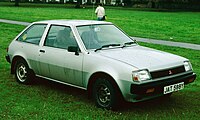Mitsubishi launched the second generation Mirage to Japan in 1983, again splitting the range into Mirage (three- and five-door hatchback, plus four-door sedan) and Lancer Fiore (four-door sedan) models. A
station wagon version of the Mirage was added in 1985, with a
four-wheel drivewagon available from the fall of 1986 with the 1.8-liter gasoline engine.
[13] Many export markets sold the hatchbacks as Mirage or Colt, with the sedan and wagon commonly badged Lancer. This wagon model went on to become very popular in both the commercial and private sectors overseas as well as in Japan.
The car received a very mild facelift in early 1986, along with some new engine options for the Japanese domestic market. The transmissions were updated at the same time.
[13]Uprated engines were deployed into the series; 1.3- and 1.5-liter
Orion gasoline engines replaced the previous 1.2- and 1.4-liter
Orion units. Mitsubishi also released variants fitted with the 1.6- and 1.8-liter
Sirius gasoline powerplants, and for the first time a 1.8-liter
Sirius diesel was added. The 1.6-liter
Sirius engine also included a
turbocharged variant with between 77 kW (105 PS) and 92 kW (125 PS), featuring the latest in computer control engine technology including
electronic fuel injection.
[12] Power differed for cars with catalyzers, or for markets with lower octane fuel. Some European markets received a smaller 1.2 litre "tax special" as well, with 55 PS (40 kW).
[14]
- Export markets
The Mirage was available in Europe as the Colt in 1200 EL and GL three-door trims, as the 1300 GL three- and five-door, 1500 GLX three- and five-door, and as the 1800 GL (diesel) five-door. The Lancer sedan was available in the same trim levels as the hatchback model (but not with the 1200 engine), while the wagon versions were available as 1500 GLX and 1800 GL diesel only. Some markets also received the 4WD Wagon with the larger 1.8 engine, although the diesel-powered 4WD remained available to Japanese customers only. Versions equipped with
catalytic converters first became available in Europe in 1985, at the same time as the wagon was introduced.
[13] The Mirage was not sold in the United States by Mitsubishi until 1985, and it was this version that made the marque's debut there. Mitsubishi licensed the "Mirage" name from Grand Touring Cars, Inc. of
Scottsdale, Arizona for use in the United States, as they already owned the rights to the name with the
Mirage race car series.
A commercial version of the wagon was sold in New Zealand as the Mitsubishi Express, replacing an earlier model based on the
Galant Sigma. The two-seater commercial type was sold in the Netherlands simply as the "Mitsubishi Wagon", whereas the better equipped passenger version was called the Lancer Station Wagon.
[14]Since there was no wagon version of the subsequent generation Colt/Mirage, production of this part of the series continued until 1991.
Mitsubishi in Thailand released the three-door and sedan models with 1.3- and 1.5-liter engine as the Mitsubishi Champ in 1983. Later the series was renamed Mitsubishi Champ II and Champ III, with the hatchback and 1.5-liter versions discontinued. The Champ was retired in 1994.
The four-door sedan formed the basis of the
Proton Saga, Malaysia's first locally built car and manufactured between 1985 and 2008.
Protonwould later spin the Saga off into its own five-door hatchback called the Saga Aeroback in 1987 (longer, and styled differently from Mitsubishi's own five-door hatchback version).
_green.JPG)


_GLXi_coupe_01.jpg)


_GLX_5-door_hatchback_01.jpg)

